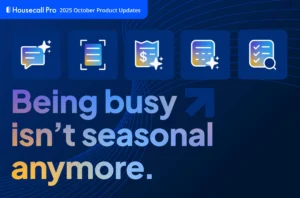Want to win more jobs with less effort?
Grow your business and send quick quotes with our home service software.

Want to see your potential revenue?
See what businesses like yours earn with Housecall Pro in 1 - 2 minutes.

Are you in the field service industry? Wondering what field services are? Field services include any work outside the office, like fixing equipment, maintenance, or setting up new systems. Think of businesses such as HVAC maintenance, landscaping, plumbing, or window cleaning services – just to name a few.
Managing teams and operations in the field requires care, organization, and good communication. In this article, we’ll share 17 best practices from our years of experience to help you make your field service operations run smoothly and effectively.
What is Field Service Management?
Field service management is the process of coordinating and overseeing all the tasks performed by field service technicians. So, if what we shared above are examples of field services, then just what is field service management?
Well, if you think about it—all of these services must be managed carefully to succeed. This involves scheduling, dispatching, tracking, and supporting technicians as they work on-site. It also includes managing inventory, ensuring proper training, and maintaining clear communication between the office and the field.
Effective field service management makes sure that jobs are completed efficiently, customer satisfaction is high, and resources are used wisely.
What Are Field Service Operations?
Field service operations involve all the tasks and activities that technicians perform on-site, away from the main office. These operations include a wide range of services, such as equipment installation, maintenance, repairs, inspections, and customer support. Field service operations require careful planning, efficient scheduling, and effective communication so that technicians arrive on time and have the necessary tools and information to complete their tasks.
These operations are super important in industries like telecommunications, utilities, healthcare, and more, where timely and reliable service is non-negotiable to meet customer needs and maintain operational efficiency.
What is Field Service Optimization?
Field service optimization involves improving the efficiency and effectiveness of field service operations. This involves using strategies and technologies to manage resources better, reduce costs, and enhance service quality. By optimizing field service, companies can dispatch technicians more effectively, complete jobs faster, and increase customer satisfaction.
This might include using advanced software for scheduling and routing, leveraging data analytics to make informed decisions, and implementing mobile solutions to keep technicians connected and informed while on the job. Field service optimization aims to make operations as smooth and productive as possible.
Understanding How to Optimize Field Service Operations
Okay, now that you understand what field service optimization is, how do you do it? As a business owner, you know that to be successful, you need to be as efficient as possible. Think of it this way—18.4% of businesses fail within the first year. And even worse, 49.7% fail within the first five years. Those are pretty alarming statistics.
This isn’t to say that nearly half of businesses fail within the first five years because of ineffective field service operations. But, many fail due to poor cash flow, which can be the result of—you guessed it—poorly optimized field service operations.
In the next section, we’ll take a look at the 17 best practices for field service management to help you optimize your operations and skyrocket your chances of long-term success.
17 Best Practices for Field Service Management
As a leading provider of software designed to help small—to mid-sized businesses operate more effectively, we have heard a lot from customers about what works for their businesses and what doesn’t. One thing we have learned is that focusing on creating a great employee experience first inevitably leads to a great customer experience and, ultimately, higher revenues and profitability.
So, we’ve compiled those insights into a list of best practices designed to help you grow and scale your business. We’ve done so in that order, focusing first on creating a great work environment that paves the way for highly satisfied customers that will help you grow your revenue. It’s a win-win-win combination.
1. Provide ongoing training and development
Many business owners hire field service employees, expecting them to know the ins and outs of the job from the get-go. But this can be disastrous. Not only can it harm your brand, but it also sets up the employee for failure. The best field service businesses invest in continuous training and development.
This includes regular workshops, online courses, on-the-job training sessions, and the assignment of a mentor to help employees stay current with industry standards and technological advancements.
2. Prioritize clear communication channels
Clear communication is a must for any successful field service operation. When everyone is on the same page, tasks are completed more efficiently, and misunderstandings are minimized. While training, as we suggested above, can help with this in a big way, we also suggest you use tools like instant messaging apps, on-my-way text solutions (your customers will love this, too), regular team meetings, and clear protocols for reporting issues to keep communication lines open.
Encourage feedback and make sure your technicians feel heard. By encouraging a culture of open and honest communication, you create a supportive work environment where employees can thrive, and customers receive the best service possible.
3. Use mobile solutions for real-time updates
Equip your field service team with mobile solutions that instantly update job assignments, customer information, and inventory status. This helps technicians stay informed and make quick decisions on the go.
Field service mobile apps can also facilitate instant communication with the office, promptly addressing any changes or issues. By leveraging mobile technology, you grow your team’s efficiency and responsiveness, ultimately leading to happier customers and smoother operations.
4. Implement GPS tracking for technicians
We know what you’re thinking—isn’t GPS tracking a bit on the big brother side? While GPS tracking can help provide insights into where your employees are, the bigger benefit is that it helps with efficiency.
For your field employees, it means routes that make sense, less time spent in traffic, and quicker response times to service calls. For customers, it means accurate arrival estimates and faster service—and we all know that today’s customers want instant gratification. Ultimately, GPS tracking creates a smoother experience for everyone, ensuring timely and reliable service that benefits your team and clients.
5. Optimize routes to reduce travel time
Travel time seriously drains productivity, and the U.S. has no shortage of road construction projects that make it more challenging to get from point A to point B. By optimizing routes, your technicians spend less time on the road and more time getting the job done. And this is about more than just the GPS tracking we mentioned above.
Route optimization and dispatching tools take into account traffic patterns, job locations, and technician availability to find the most efficient paths. This reduces fuel costs and vehicle wear and tear and allows technicians to complete more jobs in a day. No customer likes receiving a four-to-six-hour time window for service arrival. They’ll appreciate faster service and more accurate appointment windows.
6. Use automated dispatching tools
Automated dispatching tools simplify and organize the process of assigning jobs to technicians. These tools use algorithms to match the right technician to the right job based on things like location, skill set, and availability.
This means less manual scheduling—and rescheduling due to inadvertent overlaps. For technicians, it means clearer, more accurate job assignments. For customers, it results in faster response times and improved service reliability.
7. Maintain an up-to-date inventory system
How frustrating is it to head to the work truck only to find that the part you need to do the job is not there? It’s super frustrating. It’s upsetting to the customer, who needs to wait even longer for the job to be done. And it’s annoying for the employee who now needs to be the bearer of bad news to the customer. No one wants a job to take any longer than it has to.
An up-to-date inventory system helps your team always have the necessary tools and parts, minimizing delays and keeping employees and customers happy.
Get In Touch: 858-842-5746
Let us earn your trust
On average, Pros increase monthly revenue generated through Housecall Pro by 50% after their first year.
See plan options and feature breakdown on our pricing page.
8. Use advanced scheduling software
Managing schedules manually can be a nightmare, especially as your business grows. Advanced scheduling software takes the guesswork out of assigning jobs, making sure the right technician is sent to the right job at the right time. This not only saves time but also reduces errors and double bookings.
With features like automatic reminders and easy rescheduling, both your employees and customers benefit from smoother, more predictable operations. Investing in advanced scheduling software helps keep your team organized and your customers satisfied.
9. Monitor and manage technician performance
Keeping an eye on technician performance is so important for maintaining high standards and encouraging growth. Use performance metrics to identify areas where technicians excel and where they need improvement. Recognize and reward employees for excellent work through bonuses, public acknowledgment, or other incentives.
Research shows that teams who receive feedback on their strengths are 12.5% more productive than those without feedback. So, by all means, give feedback to help your team grow. This will improve morale, create a great workplace culture, and motivate your team to perform at their best. Additionally, provide constructive feedback at the moment to help them grow and improve. Timely feedback can correct issues before they become habits and show your team you are invested in their professional development.
10. Use predictive maintenance techniques
Predictive maintenance techniques help you address equipment issues before they become major problems. By analyzing data from sensors and other monitoring tools, you can predict when a piece of equipment is likely to fail and perform maintenance at the optimal time. This approach reduces unexpected downtime, extends the lifespan of your equipment, and saves on repair costs.
For technicians, it means fewer emergency calls and more planned maintenance visits. For customers, it translates to more reliable service and less disruption, creating a better overall experience.
11. Maintain regular equipment inspections
Workplace safety needs to be a priority and non-negotiable in any field-related business, and regular equipment inspections play a super important role in preventing accidents. These inspections are a fail-safe if your predictive maintenance techniques miss something. Faulty equipment can lead to serious injuries or even fatalities. In 2022, 738 workers died; in 2021-2022, there were 780,690 DART cases, including 450,050 DAFW cases.
These injuries can occur in various ways, such as being struck by moving objects, bumping into equipment, getting pinched or crushed, or being injured by collapsing structures or due to vibration. Regular inspections help identify and address potential hazards, ensuring that equipment is in good working order and safe to use.
12. Prioritize compliance with safety standards
Following safety standards needs to be the name of the game for protecting your team and avoiding costly penalties. Implement regular training sessions to keep employees updated on the latest safety protocols and regulations. Conduct frequent safety audits to identify and fix potential hazards—we can’t reiterate enough the need for equipment safety inspections.
Encourage a safety culture by rewarding safe practices and promptly addressing any violations. By prioritizing safety, you create a secure work environment that minimizes the risk of accidents and injuries.
13. Offer remote support options
Incorporating remote support options is a game-changer for field service operations. Technologies such as augmented reality (AR) and video conferencing enable technicians to receive real-time assistance from experts without being physically present. This speeds up problem resolution and reduces travel costs and downtime—something your customers will really appreciate.
Remote diagnostics and guided troubleshooting empower technicians to solve issues more efficiently, enhancing their capabilities and boosting customer satisfaction. By leveraging these advanced tools, you can provide faster, more effective service, helping your team and clients benefit from the latest innovations in remote support.
14. Implement a customer feedback system
A customer feedback system is essential for understanding how your service is perceived and identifying areas for improvement. Encourage customers to share their experiences through surveys, online reviews, and direct feedback. Analyze this feedback to gain insights into what’s working well and where you can improve.
Responding to positive or negative feedback shows customers that you value their opinions and are committed to enhancing their experience. This helps you refine your services and builds stronger relationships with your customers. And the result is increased satisfaction and loyalty.
15. Collect and analyze data regularly
No matter what type of business you are in, from pool and spa, to pest control, to home remodeling and everything in between, you need to pay attention to the data. Are there changes in customer demand? Are customer needs changing? What is going on with seasonality? Are your technicians taking more or less time to complete jobs than before?
By gathering data on technician performance, job completion times, customer feedback, and equipment status, you can identify trends and areas for improvement. Use this data to optimize your operations, predict future needs, and address issues before they become major problems.
Any business needs to innovate to succeed. Looking at the data and acting on it will help you do that.
16. Implement a robust reporting system
Do you look at the data and simply mutter to yourself, hey, that’s interesting? Or do you actually do something with the data you are seeing? A robust reporting system provides transparency and accountability in your field service operations. Detailed reports on technician performance, job completion rates, customer satisfaction, and other key metrics help you track progress and identify areas for improvement.
Regular reporting keeps everyone on the team on the same page and informs them about performance and goals. This helps make data-driven decisions and aligns the team’s efforts towards common objectives. Great reporting is part of your roadmap to business success.
17. Create a culture of continuous improvement
It’s important to never take your company’s success for granted. Sure, you should take the time to celebrate the wins. But, don’t allow yourself to get too comfortable in how your company is performing today because things can always change tomorrow.
Creating a culture of continuous improvement involves encouraging your team to always look for ways to enhance their skills and processes. Promote regular training, open communication, and feedback loops where employees can share ideas for improvement.
As we said, celebrate successes but also learn from failures. Focusing on continuous improvement keeps your team engaged and motivated, driving higher performance and better service delivery.
Grow Your Business With Field Service Management Software
We know we threw a lot your way. And, you don’t have to take our advice on all of our suggestions. But, we’re quite confident that if you try out a few of these, you’ll see a change in your business—for the better. Plus, if you don’t try anything else, be sure to prioritize your 14-day no-cost trial of Housecall Pro. Within two weeks of using our field service management software, you’ll see the benefits of more effective and efficient field service operations. You’ll wonder why you waited so long to get started.





